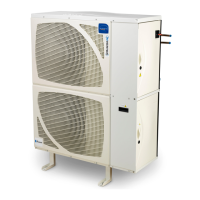| Installaon Instrucons
■ 4.1. Prevenng leakage
All connecons must be systemacally checked for any leakage
with an electronic leakage detector suitable for the type of
refrigerant used. A leak test can be carried out before pulling a
vacuum by using a pre-charge of nitrogen and a leak detecon
aerosol (refrigerant tracers not approved) around the joints.
Do not over pressurize the system when using nitrogen. A
more accurate check using an electronic leakage detector can
be carried out aer charging with refrigerant.
■ 4.2. Pulling a vacuum
Pull a deep vacuum on the installaon to about 200 microns
mercury or 0,27 mBar, with a suitable vacuum pump.
We recommend that a vacuum is pulled simultaneously from
both high and low pressure sides of the system to ensure
a uniform vacuum throughout the system including the
compressor and to reduce the amount of me required to
obtain the vacuum.
■ 4.3. Refrigerant charge
Charge the installaon using only the refrigerant for which the
unit has been designed (see idencaon plate).
Charging with refrigerant will always take place in the liquid
phase in order to maintain the correct blend of zeotropic
refrigerants.. Pre charge will be realized on the liquid line.
Addional charge will be conducted on the sucon line unl
obtaining the nominal operang mode of the installaon
(installaon operaon). See paragraph “Pre-start check list”
before powering.
NEVER START THE COMPRESSOR UNDER VACUUM, WHETHER
HBP OR LBP and ensure before starng that the compressor
casing is under posive pressure. We therefore recommend to
de charger lentement le circuit frigorique entre 4 et 5 bars s’il
est au R-404A et à environ 2 bars s’il est au R-134a.
Pre-start check list
Make sure that:
1. The power supply voltage is compable with that of the
condensing unit.
2. Electrical safety devices are set correctly for the
condensing unit.
3. Service valves are fully open.
4. The crankcase heater is working.
5. Condensing unit fan blades rotate freely.
6. The installaon is given a nal check for any possible
faults.
7. In the case of three-phase scroll compressors, control
the order of the phases of the power supply so that the
rotaon of the motor allows the compression of the
refrigerant. Reverse 2 phases if necessary.
8. In the case of the presence of a controller, read the
enclosed leaet and check the seng values set by
default.
9. The design of the refrigeraon system must be such that
it does not allow the compressor to start more than 6 to
8 mes per hour.
Check list aer start up
Aer the installaon has been running for several hours, carry
out the following checks.
1. Voltage and current drawn by the condensing unit are
correct.
2. Direcon of rotaon of Scroll and Rotary compressors.
3. Pressure switch adjustment.
4. High and low operang pressures of the installaon are
correct.
5. Fan blades are rotang freely
6. Superheat and sub cooling
7. Oil level check for mul piston and scroll compressors
8. The system is checked again for leaks.
9. For remote installaon please refer to the
‘recommendaons of use handbook’.
Make sure that the installaon is running smoothly.
Carry out a general inspecon of the installaon (e.g.
cleanliness, vibraon and/or unusual noises). Ensure the
sengs and the funcons of the electrical circuits are correct.
- High and low pressure values that are too low
- An evaporator that is parally frozen
- The presence of bubbles on the sight glass.
- A high pressure value that is too high
- Over consuming compressor
- Important sub cooling
- A liquid return
■ 4.4. Fan speed control
The rotaonal speed of the fan(s) is controlled by a pressure
actuated fan speed control. Its funcon is to:
- Prevent an excessive drop in condensing pressure in winter
which would adversely aect the correct operaon of the
expansion valve,
- Further reduce noise levels when the ambient temperature
allows.
See Appendix 5, page 35 on fan speed control
2 types of commands for compressors assembled in parallel
are possible:
- Piston compressor: a simple contact acvated by a
thermostat or pressure controller (operaon in pump down).
- Scroll compressor: electronic controller set up in Silensys®
acvates on-o control of compressors according to the
sucon pressure and running me.
5- SERVICING AND MAINTENANCE
Unauthorized modicaons to Silensys® condensing units are
prohibited. Authorizaon from Tecumseh must be obtained
prior to any modicaon whatsoever.
Any faulty part must be replaced with a genuine spare part. In
order to maintain the low noise levels of the condensing unit
over me, we recommend replacing the an-vibraon mounts
and/or isolang pads as soon as any change in the noise or
vibraon level of the unit is noced.
Connecons, fan and compressor compartments can be
accessed from either the side door panel or the front of the
unit, without removing the lid.
■ 5.1. Condenser
The condenser and the condensing unit should be cleaned at
least once a year. Access from the inside of the unit can be
gained by removing the fan cover.
■ 5.2. Replacing the fan
- Switch o and isolate the condensing unit.
- Disconnect the fan motor cable from the juncon box.
- Undo the 4 mounng bolts.
- Take o the fan motor assembly.
- Replace the fan motor and its capacitor ( size S model).

